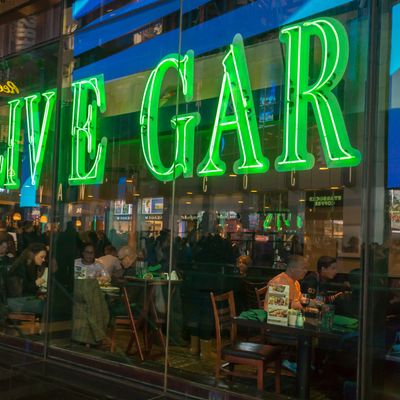
It was mid-afternoon on the first day of indoor dining’s return to the city, and Maddy Rotman was waiting for two friends outside the Olive Garden in Times Square. The 26-year-old grew up watching commercials for the chain’s trademark combo of unlimited soup, salad, and breadsticks, but her parents had never taken her to try it. After moving to the city, she joked with friends about going to Olive Garden, although the one time Rotman tried to throw a birthday party there, she learned that nobody else actually wanted to go. She went mini-golfing instead.
But now Rotman is leaving New York for a new job in California, which means she has some leverage. After months of social distancing and isolation, who could deny her this request? Certainly not Rotman’s friends, who did show up for an honest-to-God last supper at the world’s biggest Italian chain restaurant.
Rotman said she was genuinely curious about the breadsticks she had long been denied, and she wanted to see who else would be inside. Since opening in 1994, the three-story Olive Garden flagship has evoked a loathing from native New Yorkers that is so deep — so visceral — that it’s actually sort of weird. But for all the shade it gets as the city’s preeminent symbol of suburban creep, the restaurant is also very, very popular. The CEO of Darden Restaurants, which owns the Olive Garden chain, said last week in a call to investors that the Manhattan location is the best performer in the entire chain and usually pulls in about $300,000 a week, or $15 million a year.
This has not been the case during the pandemic. Takeout brings in a tiny portion of Olive Garden’s regular sales, and setting up outdoor dining hasn’t been an option for a restaurant that is quite literally located in the center of Times Square. And even if it had been an option, who would fill the seats? There aren’t a ton of tourists to trap. Broadway has gone dark. Only 8 percent of the city’s office workers had returned to their desks as of August.
Hypothesizing about who eats at the Times Square Olive Garden is a perennial pastime among New Yorkers — a Reddit thread asking people to defend their decision to do so went absolutely viral in 2017 — but I wanted to know who, exactly, would make the chain restaurant in midtown their first stop after being denied access to New York City’s dining scene for the better part of a year. At a time when people are understandably worried about losing local institutions, who would show up to support an international chain that was just accused of violating the Civil Rights Act with its tipping practices?
Minutes after a manager unlocked the Times Square Olive Garden’s doors, three couples showed up looking for tables. When I sat down for lunch, around 1 p.m., guests were seated only in the corners of the room, with many tables in the center of the dining area covered in signs that read, “Social Distancing Is Temporary, But Family Is Forever.” The signs were knowingly corny in that way so much of the chain-restaurant dining experience can be, but they also spoke to the fact that a 500-seat dining room in midtown may provide one of the safest possible indoor dining experiences in the city right now.
I lingered until about 9 p.m., and I never saw more than about ten people dining at once the whole time I was there. Plus, companies like Darden are built on a foundation of detailed rules and mandates for staff. While that may not make for an authentic — whatever that means — Italian dining experience, it’s actually pretty ideal during a pandemic.
Another customer, Alex, picked up on the same vibe. She lives in Amityville, Long Island, and has not eaten in a restaurant there since March because she thinks it’s unsafe. “There, they don’t even have hand sanitizer,” she said. “They’re not doing what they’re supposed to be doing.” But when she had to go to midtown for an appointment that coincided with Wednesday’s reopening, she knew she would go to either the giant Red Lobster or Olive Garden to eat. “Here, you line up outside, and they take your temperature,” she pointed out.
While several people expressed that they thought Olive Garden was a safe bet, many more, like Jay Miles, said he was just trying to feel normal again. His last meal before the shutdown was his favorite: the chain’s Five Cheese Ziti al Forno. He has been back at the Spectrum office in midtown since June and vowed to have the same thing again the first chance he got, even though it’s a splurge for a midweek meal. “I’m just so excited to be back here,” he said.
Another customer, Catherine, a college student, was excited too. She had regularly been getting takeout from Olive Garden with her boyfriend since the pandemic started, and she said the food reminds them of their suburban childhood at a time when they miss their families and are struggling to stay sane in their adopted city. When they arrived at their favorite spot that evening and saw it was actually open, they made the impulsive decision to lean into the illusion that the clock had been turned back to pre-pandemic times, at least for an hour. “New York doesn’t really have comfort food,” Catherine said, “but that’s what this is to us.”
Catherine may be alone in thinking New York doesn’t offer any comfort food, but the Times Square Olive Garden does have a strange, undeniable history as a place of reprieve during periods of trauma and distress. In that viral Reddit thread from a few years ago, one person described going there to charge their phone and regroup during Hurricane Sandy. A former NYPD officer shared a story about how the place was open only to emergency workers in the weeks following 9/11. “The full menu was available, for free, no charge,” he wrote. “We tried to tip the wait staff, they wouldn’t accept it. Honestly it was fucking amazing. You would be working 12, 14, 18 hour shifts and you could go here, eat and relax. I’ll never forget the hospitality we received.” In a 2005 medical-journal article, an emergency doctor also recounted going to Olive Garden not long after 9/11. She said a quick-thinking waiter there performed CPR on her father and helped save his life. She’s forever grateful. “We still go back to the Olive Garden,” she wrote. “Usually in September.”
The next day, I followed up with Rotman about her dining experience. She loved it. Though she admits she initially went there as a joke, she said that drinking a bottle of red wine with her friends, sopping up the alcohol with overcooked spaghetti, and trying not to get dizzy from the bright lights that blaze up and down Broadway ended up being an ideal farewell to a city that never, even in a pandemic, stops providing new ways to make people feel connected and alive. “The wait staff was so kind — and grateful to have guests — and I was grateful to see a metal fork instead of the plastic we’ve all endured fearing illness,” she said. “I might not go back to an Olive Garden, because that was the most perfect experience I may ever have.”




